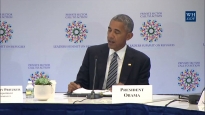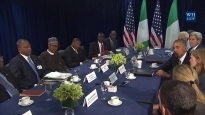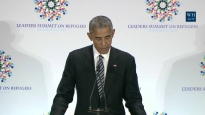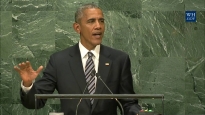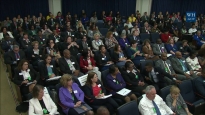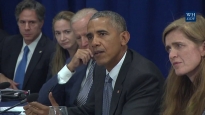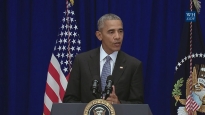President Obama Presents a Night of Astronomy
October 7, 2009 | 9:43
The President and First Lady host NASA astronauts, area middle schoolers, and innovators in the field of astronomy for a night of fun, learning, and stargazing on the South Lawn. October 7, 2009. (Public Domain)
Remarks by the President at the National Medal of Science and National Medal of Technology and Innovation Ceremony
THE WHITE HOUSE
Office of the Press Secretary
________________________________________________________________
For Immediate Release October 7, 2009
________________________________________________________________
For Immediate Release October 7, 2009
REMARKS BY THE PRESIDENT
AT THE NATIONAL MEDAL OF SCIENCE AND
NATIONAL MEDAL OF TECHNOLOGY AND INNOVATION CEREMONY
AT THE NATIONAL MEDAL OF SCIENCE AND
NATIONAL MEDAL OF TECHNOLOGY AND INNOVATION CEREMONY
East Room
1:52 P.M. EDT
THE PRESIDENT: Thank you so much. Thank you. Everyone please have a seat. Before I begin the ceremony to introduce these extraordinary innovators, let me just mention a few people who are in the audience today. First of all, we've got some outstanding members of my Cabinet: Secretary Locke, Secretary Sebelius, Secretary Chu, and Administrator Jackson. We are very grateful for all the outstanding work they're doing.
THE PRESIDENT: Thank you so much. Thank you. Everyone please have a seat. Before I begin the ceremony to introduce these extraordinary innovators, let me just mention a few people who are in the audience today. First of all, we've got some outstanding members of my Cabinet: Secretary Locke, Secretary Sebelius, Secretary Chu, and Administrator Jackson. We are very grateful for all the outstanding work they're doing.
We've got some wonderful partners in Congress that I want to mention: Senator Jeff Merkley of Oregon; Senator Jim Risch of Idaho; Senator -- Representative Rush Holt. Rush, I almost gave you a promotion there -- (laughter) -- or a demotion, depending on how you look at it -- (laughter) -- of New Jersey; Representative Anna Eshoo of California; and Representative Zoe Lofgren of California. I also want to mention my science advisor who is doing outstanding work, Dr. Holdren is here, as well as NASA Administrator Charles Bolden. And we want to thank some of the people who helped to organize today's event -- the National Science Foundation and its director, Arden Bement; the U.S. Patent and Trademark Office and its director, Dave Kappos; and Linda Katehi, the chair of the National Medals of Science and Technology and Innovation Committee. So give all of them a big round of applause. (Applause.)
Now, it's also a real pleasure to have so many distinguished researchers and innovators joining us, although I must admit that I have an ulterior motive for presenting these awards today. You see, Sasha has a science fair coming up. (Applause.) And I was thinking that you guys could give us a few tips. (Laughter.) Michelle and I are a little rusty on our science. (Laughter.)
In all seriousness, it is a privilege to present these medals, our nation's highest honor for scientific and technological achievement, to the folks who've come here today from all parts of our country and all areas of scientific investigation. The scientists in this room have plumbed the furthest reaches of the universe and the deepest recesses of the human mind; they've sequenced the human genome and stimulated the workings of the atom; they've developed technologies that have greatly improved our understanding of the human body and the natural world; and they've fostered innovations that have saved millions of lives and improved countless more.
So this nation owes all of you an enormous debt of gratitude far greater than any medal can bestow. And we recognize your contributions, but we also celebrate the incredible contributions of the scientific endeavor itself. We see the promise -- not just for our economy but for our health and well-being -- in the human capacity for creativity and ingenuity. And we are reminded of the power of free and open inquiry, which is not only at the heart of all of your work, but at the heart of this experiment we call America.
Because throughout our history, amid tumult and war and against tough odds, this nation has always looked toward the future and then led the way. It was during the darkest days of the Civil War that President Lincoln established the land grant colleges and the National Academy of Science. It was during World War II that President Roosevelt requested that Vannevar Bush -- his science advisor and a future recipient of the National Medal of Science -- outline a set of policies to maintain our scientific and technological leadership in the 20th century.
And it was in the years that followed the Soviet launch of Sputnik, the first artificial satellite to orbit the Earth, that the United States would create DARPA, NASA, and the National Defense Education Act, which helped improve math and science education from grade school to graduate school. In fact, the National Medal itself was established just two years after that launch, as a sign to the world and to ourselves of how highly we valued the work of the nation's scientists.
Today, we face more complex challenges than generations past. A medical system that holds the promise of unlocking new cures -- attached to a health care system that has the potential to bankrupt families and businesses. A system of energy that powers our economy but endangers our planet. Threats to our security that seek to exploit the very interconnectedness and openness that's so essential to our prosperity. And challenges in a global marketplace which link the trader on Wall Street to the homeowner on Main Street, and the office worker in America to the factory worker in China -- we all share an opportunity, but we also all share in crisis.
At such a difficult moment, there are those who say we can't afford to invest in science, that it's a luxury at a moment defined by necessities. I could not disagree more. Science is more essential for our prosperity, our security, and our health, and our way of life than it has ever been. And the winners we are recognizing only underscore that point, with achievements in physics and medicine, computer science and cognitive science, energy technology and biotechnology. We need to ensure that we are encouraging the next generation of discoveries -- and the next generation of discoverers.
That's why my administration has set this goal: by investing in education, funding basic and applied research, and spurring private innovation, we will devote 3 percent of our gross domestic product to research and development. That's more than at any point in recent history. (Applause.)
And as part of this effort, we're putting in place policies that will move us from the middle to the top of the pack in math and science education over the next decade. We are challenging states to dramatically improve achievement by raising standards, by improving the use of technology, and by making it possible for professionals like our honorees to bring a lifetime of experience and enthusiasm into the classroom. And we've also launched a Race to the Top fund to encourage states to compete for the most innovative programs in math and science, as part of a broader effort to foster new ways of engaging young people in these fields.
The White House is participating, too. Tonight, in fact, we're bringing children to the South Lawn for a night of astronomy. I am really looking forward to this. (Laughter.) This is going to be fun. They'll peer through telescopes, wander through exhibits, and hopefully feel a sense of wonder that might one day lead them here to receive a medal themselves.
And my administration has set another goal to compete for the jobs of the future and to encourage the scientists and engineers of the future. By 2020, America will once again have the highest proportion of college graduates in the world. We used to be number one. We have fallen behind. We are going to regain our position. (Applause.)
To meet this goal, we've increased the Pell Grant and passed legislation through the House -- which we're working to pass through the Senate -- to end more than $80 billion in wasteful subsidies to lenders and use that money instead to help students.
Beyond the classroom, the Recovery Act that we passed is funding the largest single boost to biomedical research in history. My budget makes the research and experimentation tax credit permanent to help companies afford the often high cost of innovation. I've proposed eliminating the capital gains tax for investments in startups and small companies -- because countless big ideas begin in small businesses. And we are doubling our capacity in renewable energy, even as we seek to create a system of incentives to make clean energy the profitable kind of energy in America.
For at our best, this nation has never feared the future. We've shaped the future. Even when we've endured terrible storms, we haven't given up or turned back -- we've remain fixed on that brighter horizon. That's how we've led in the pursuit of scientific discovery; and in turn that's how science has helped us lead the world.
There's no better illustration than what took place at the close of World War II, when the United States transported dozens of captured V-2 rockets from Germany to New Mexico. These were among the most sophisticated weapons in the world, a reminder that much of World War II was fought far from the battlefield -- by Alan Turing in Bletchley Park, and Oppenheimer in Los Alamos, and by countless others who developed radar and aircraft and antibiotics.
The military wanted to understand this new missile technology that the V-2 represented; but scientists were also invited to use these tests to take measurements of the atmosphere. And then one engineer had an idea: to rig a camera and attach it to one of the rockets. And so in this brief moment between the end of a world war and the start of a cold war, a group of scientists erupted with joy as they discovered that they had captured the very first photos of our world as seen from space. Their work would continue as the Rocket and Satellite Research Panel. And after the launch of Sputnik in 1957, the work of this panel would be assumed by a new agency, called NASA. The research into these weapons of war would lead to the missions of Mercury and Gemini and Apollo.
That's the incredible promise of the work scientists do every day -- like the scientists, researchers, and engineers, and innovators we honor with these medals. Yes, scientific progress offers us a chance to achieve prosperity and defend our nation. It has offered us benefits that have improved our lives and our health -- improvements that we often take for granted. But it also gives us something more. At root, science forces us to reckon with the truth as best as we can ascertain it, and to reckon with the power that comes from this knowledge -- for good and for ill. With each new discovery brings new responsibility to move past our differences and to address our shared problems; to embrace a sense of wonder, and our common humanity.
Carl Sagan, who helped broaden the reach of science to millions of people, once described his enthusiasm for discovery in very simple terms. He said, "Somewhere, something incredible is waiting to be known." (Laughter.) Thank you all for the incredible discoveries that you have made, the progress you've invented, and the benefits you've bestowed on the American people and the world.
So it is now my honor to ask the recipients to come forward to receive their medals, and as their citations are read I will -- you'll just have to bend down a little bit -- (laughter) -- and we will bestow on you the highest honor that our nation can give you for your science, technology, and innovation.
So, do we have someone here for the citations?
MILITARY AIDE: Dr. Berni Alder. (Applause.) 2008 National Medal of Science to Dr. Berni Alder, Lawrence Livermore National Laboratory, for establishing powerful computer methods useful for molecular dynamic simulations, conceiving and executing experimental shock-wave simulations to obtain properties of fluids and solids at very high pressures, and developing Monte Carlo methods for calculating the properties of matter from first principles, all of which contributed to major achievements in the science of condensed matter.
(The medal is presented.) (Applause.)
Dr. Francis S. Collins. (Applause.) 2008 National Medal of Science to Dr. Francis S. Collins, National Institutes of Health, for his visionary contributions to the fields of genetics and genomics through the work of his own laboratory and his leadership of multiple international genomics initiatives, including the Human Genome Project.
(The medal is presented.) (Applause.)
Dr. Joanna S. Fowler. (Applause.) 2008 National Medal of Science to Dr. Joanna S. Fowler, Brookhaven National Laboratory, for her pioneering work in chemistry involving the synthesis of medical imaging compounds and her innovative applications of these compounds to human neuroscience, which have significantly advanced our understanding of the human brain and brain diseases, including drug addiction.
(The medal is awarded.) (Applause.)
Dr. Elaine Fuchs. (Applause.) 2008 National Medal of Science to Dr. Elaine Fuchs, The Rockefeller University, for her pioneering use of cell biology and molecular genetics in mice to understand the basis of inherited diseases in humans and her outstanding contributions to our understandings of the biology of skin and its disorders, including her notable investigations of adult skin stem cells, cancers, and genetic syndromes.
(The medal is awarded.) (Applause.)
Dr. James E. Gunn. (Applause.) 2008 National Medal of Science to Dr. James E. Gunn, Princeton University, for his brilliant design of many of the most influential telescopes and instruments in astronomy, and in particular for the crucial role those technological marvels played in the creation of the Sloan Digital Sky Survey, which has cataloged 200 million stars, galaxies, and quasars; discovered the most distant known quasars; and probed the epoch of formation of the first stars and galaxies.
(The medal is awarded.) (Applause.)
Dr. Rudolf E. Kálmán. (Applause.) 2008 National Medal of Science to Dr. Rudolf E. Kálmán, Swiss Federal Institute of Technology, for his fundamental contributions to modern system theory, which provided rigorous mathematical tools for engineering, [econometrics], and statistics, and in particular for his invention of the "Kálmán filter," which was critical to achieving the Moon landings and creating the Global Positioning System and which has facilitated the use of computers in control and communications technology.
(The medal is awarded.) (Applause.)
Dr. Michael I. Posner. (Applause.) 2008 National Medal of Science to Dr. Michael I. Posner, University of Oregon, for his innovative application of technology to the understanding of brain function, his incisive and accurate modeling of functional tasks, and his development of methodological and conceptual tools to help understand the mind and the development of brain networks of attention.
(The medal is presented.) (Applause.)
Dr. JoAnne Stubbe. (Applause.) 2008 National Medal of Science to Dr. JoAnne Stubbe, Massachusetts Institute of Technology, for her groundbreaking experiments establishing the mechanisms of ribonucleotide reductases, polyester synthases, and natural product DNA cleavers -- compelling demonstrations of the power of chemical investigations to solve problems in biology.
THE PRESIDENT: He had to practice that. (Laughter.)
(The medal is presented.) (Applause.)
MILITARY AIDE: Dr. J. Craig Venter. (Applause.) 2008 National Medal of Science to Dr. J. Craig Venter, J. Craig Venter Institute, for his dedication to the advancement of the science of genomics, his contributions to our understanding of its implications for society, and his commitment to the clear communication of information to the scientific community, the public, and policymakers.
(The medal is presented.) (Applause.)
Dr. Forrest M. Bird. (Applause.) 2008 National Medal of Technology and Innovation to Dr. Forrest M. Bird, Percussionaire Corporation, for his pioneering inventions in cardiopulmonary medicine, including the medical respirator; devices that helped launch modern-day medical evacuation capabilities; and intrapulmonary percussive ventilation technologies, which have saved the lives of millions of patients in chronic obstructive pulmonary disease and other conditions.
(The medal is presented.) (Applause.)
Dr. Esther Sans Takeuchi. (Applause.) 2008 National Medal of Technology and Innovation to Dr. Esther Sans Takeuchi, University at Buffalo, the State University of New York, for her seminal development of the silver vanadium oxide battery that powers the majority of the world's lifesaving implantable cardiac defibrillators, and her innovations in other medical battery technologies that improve the health and quality of life of millions of people.
(The medal is presented.) (Applause.)
Dr. John E. Warnock and Dr. Charles M. Geschke. (Applause.) 2008 National Medal of Technology and Innovation to Dr. John E. Warnock and Dr. Charles M. Geschke, Adobe Systems Incorporated, for their pioneering technological contributions that were central to spurring the desktop publishing revolution and for their role in changing the way people create and engage with information and entertainment across multiple mediums including print, video, and the Web.
Dr. John E. Warnock and Dr. Charles M. Geschke. (Applause.) 2008 National Medal of Technology and Innovation to Dr. John E. Warnock and Dr. Charles M. Geschke, Adobe Systems Incorporated, for their pioneering technological contributions that were central to spurring the desktop publishing revolution and for their role in changing the way people create and engage with information and entertainment across multiple mediums including print, video, and the Web.
(The medal is presented.) (Applause.)
Mr. Samuel Palmisano, accepting for IBM Corporation. (Applause.) 2008 National Medal of Technology and Innovation to IBM Corporation for the IBM Blue Gene supercomputer and its systems architecture, design, and software, which have delivered fundamental new science, unsurpassed speed, and unparalleled energy efficiency and have had a profound impact worldwide on the high-performance computing industry.
(The medal is presented.) (Applause.)
THE PRESIDENT: Well, that -- the ceremony is over, but I think it would be appropriate for everybody to, again, to stand up and give these recipients a big round of applause. (Applause.)
END
2:17 P.M. EDT
2:17 P.M. EDT
|
September 20, 2016
|
September 20, 2016
|
September 20, 2016
|
September 20, 2016
|
|
September 20, 2016
|
September 19, 2016
|
September 19, 2016
|
September 19, 2016
|
- &lsaquo previous
- …
- 21
- 22
- 23
- 24
- 25
- 26
- 27
- 28
- 29
- …
- next &rsaquo
